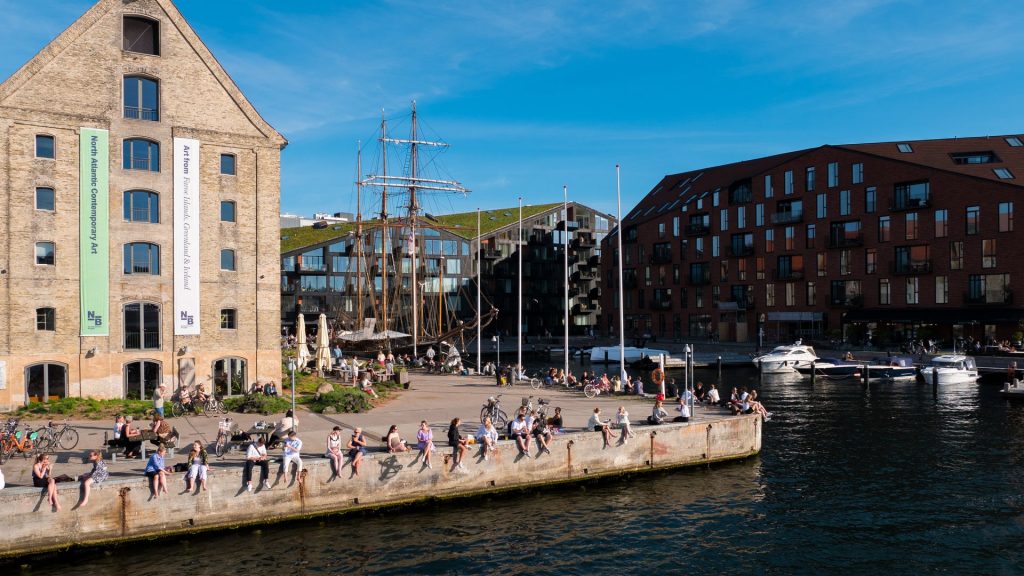Aus Norddeutschland ist es nicht allzu weit nach Kopenhagen – sowohl mit dem Zug, als auch mit dem Auto. Aber auch mit einer längeren Anreise lohnt sich meiner Meinung nach ein Besuch der dänischen Hauptstadt, die 2023 von der UNESCO zur Welthauptstadt der Architektur ernannt wurde.

Bei meinem letzten Besuch in Kopenhagen ist mir wieder aufgefallen, welch eine entspannte Atmosphäre in der Stadt herrscht. Es gibt viel Grün, viel Wasser und viel Raum für Fußgänger und Radfahrer und für eine Metropole sind erstaunlich wenig Autos unterwegs. Denn Kopenhagen wurde in den vergangenen Jahren (oder wohl eher Jahrzehnten) mit dem Fokus umgestaltet und weiterentwickelt, dass vor allem eines im Mittelpunkt steht: Die Lebensqualität der EinwohnerInnen. Getreu dem Motto von Kopenhagens einflussreichstem Stadtplaner Jan Gehl – „Städte für Menschen“ zu gestalten.
Um Welthauptstadt der Architektur zu werden, kommen zum Fokus auf die Lebensqualität noch ein gehöriger Mut zur kreativer Architektur hinzu. Ein Beispiel ist CopenHill – eine Müllverbrennungsanlage auf der man Ski fahren kann, aber auch neue Studentenwohnheime, Büros oder Kindergärten beeindrucken durch besonderes Design und oft durch die Einbindung von viel Grün.


Neben der Architektur geht Designfreunden bei den dänischen Möbel- und Designmarken das Herz auf und so gibt es auch in Kopenhagen viel zu entdecken. Ob in den vielen kleinen und großen Läden oder auch beim Besuch von Hotels und Restaurants, von denen es viele gibt, die schon allein vom Design und der Atmosphäre her Freude machen. So wie die Gro Spiseri, die Teil des Urban Farming-Projektes ØsterGro ist (ganz oben auf dem Foto).

COAST – @coaststudio



Eines der Restaurants, das sicherlich am meisten Atmosphäre ausstrahlt, ist das Noma. Mehrfach als bestes Restaurant der Welt ausgezeichnet, ist es (naturgemäß für Sterneküche) preistechnisch nur einer kleinen Gruppe Menschen zugänglich, was schade ist, denn das Design hat für mich etwas sehr bodenständiges und gemütliches und hebt sich wohltuend von so manch gehobenen Restaurant ab, in dem man das Gefühl hat, steif dasitzen zu müssen und bloß nicht laut zu lachen.


Ein (wie ich finde) Muss für Kopenhagen-Reisende ist ein Abstecher ins Louisiana Museum of Modern Art nördlich von Kopenhagen. Wer mit dem Auto dort ist, kann auf dem Rückweg auf der Küstenstraße 152 an einem der vielen Möglichkeiten an den Strand gehen, wie beim Seebad Charlottenlund, und den Tag mit einem erfrischenden Bad in der Ostsee ausklingen lassen.






It’s not too far to Copenhagen from northern Germany – either by train or by car. But even if you have a longer journey, I think it’s worth visiting the Danish capital, which was named the UNESCO World Capital of Architecture in 2023.
During my last visit to Copenhagen, I once again noticed the relaxed atmosphere in the city. There is plenty of greenery, lots of water and plenty of space for pedestrians and cyclists, and for a metropolis there are surprisingly few cars on the road. This is because Copenhagen has been redesigned and developed in recent years (or rather decades) with a focus on one thing above all else: The quality of life of its inhabitants. True to the motto of Copenhagen’s most influential urban planner Jan Gehl – to design „cities for people“.
To become the world capital of architecture, the focus on quality of life needs to be complemented by a great deal of courage in terms of creative architecture. One example is CopenHill – a waste incineration plant on which you can go skiing, but new student residences, offices and kindergartens also impress with their special design and often the integration of lots of greenery.
In addition to the architecture, Danish furniture and design brands make design lovers‘ hearts beat faster and there is plenty to discover in Copenhagen. Whether in the many small and large stores or when visiting hotels and restaurants, of which there are many, the design and atmosphere alone are a joy. Like the Gro Spiseri, which is part of the ØsterGro urban farming project (at the top of the photo).
Of all the restaurants I know, one that exudes the most atmosphere is Noma. Having been named the best restaurant in the world several times, it is only accessible to a small group of people in terms of price (naturally for Michelin-starred cuisine), which is a pity, because I find the design very down-to-earth and cozy and it stands out pleasantly from many an upscale restaurant where you feel like you have to sit stiffly and not laugh out loud.
A must (in my opinion) for travelers to Copenhagen is a detour to the Louisiana Museum of Modern Art north of Copenhagen. If you are there by car, on the way back you can take the coastal road 152 to one of the many beaches, such as the seaside resort of Charlottenlund, and end the day with a refreshing dip in the Baltic Sea.
Titelbild: Giuseppe Liverino @tourbillondel

